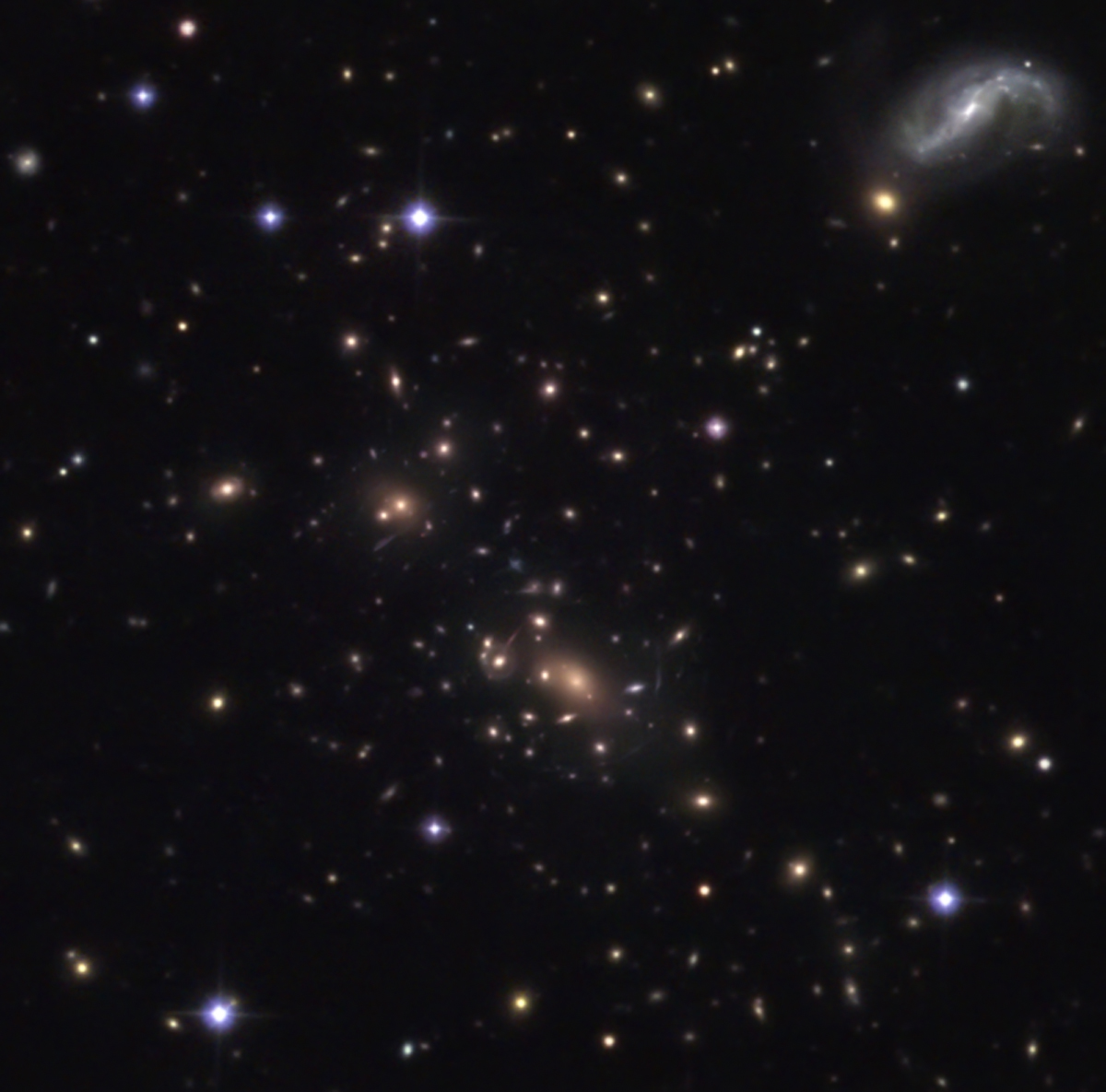
[back] Abell 2218 (Galaxy Cluster Lense) in Draco[NED]
High resolved image / hoch aufgelöstes Bild (3186 x 2202 Pixel)

|
distance: ~650Mpc/2000MLy, |
|
120" |
|
(c) 2008 All astro photo images are copyrighted. They may not be used or reproduced without explicit written permission from the authors.
150% version of the lensing part: / 150%-Version des linsenden Teils:

(c) 2008 All astro photo images are copyrighted. They may not be used or reproduced without explicit written permission from the authors.
About this Image / Über dieses Bild
| CCD: | SBIG STL-11000M |
| Image Type, Orientation: | L-RGB Composite, North is at 15:15 |
| Exposure time: | L: 13x900 sec. 1x1 bin, R,G,B: 3x900 sec. 2x2 bin, L-(R+G) was mixed to B to compensate bad seeing conditions during B exposures |
| Exposure date: | May 31st/ June 1st, 2008 |
| Location: | Skinakas Observatory at Crete, Greece, remote-controlled from Bad Arolsen/Germany |
| Filter: | SBIG 2" LRGB filter set for STL |
| Instrument: | Ganymed 60cm-Hypergraph in secondary focus (f=4940 mm) |
| Photographer: | Josef Pöpsel, Stefan Binnewies |
| Image seeing (FWHM): | 0.77".. 1.12" for the L frames. 0.77" image seeing on a 15 minute exposure is the "high score" of Ganymed at the moment |
| Remarks: |
Abell 2218 is a cluster of galaxies about 2 billion light years away (z ≈ 0.18). Caused by its mass it serves as a lens for galaxies even more far away behind the cluster. These galaxies appear as arcs in the image. The image below shows the red shift of the lensed galaxies (see http://www.astro.caltech.edu/~rse/firstlight/).Therefore these galaxies are (and will be) the distance record holders (Z=2.515) of non point shaped galaxies on our web site. As far as we know up to now (June 2008) this image is the only color image of gravitational arcs done by amateurs. Even for the professional astronomers colored images of gravitational arcs are rare. All the more it is impressive, that large telescopes like the Keck I are capable to do spectra of these dim areas, which were used to measure the red shifts displayed below. DDP and CCDSharp (three iterations) were used. |
|
|
|
|
Bemerkungen: |
Abell 2218 ist ein Galaxienhaufen in ca. 2 Mrd. Lichtjahren Entfernung (z ≈ 0.18), der durch seine Masse als Linse für noch weiter dahinter befindliche Galaxien wirkt, die verzerrt als Bögen erscheinen. Im Bild unten sind die Rotverschiebungen der gelinsten Galaxien dargestellt (nach http://www.astro.caltech.edu/~rse/firstlight/). Damit dürften die abgebildeten Galaxien auf Dauer den Rekord als am weitesten entfernte flächenhaft abgebildete Galaxien auf dieser Web-Site halten (z=2,515). Soweit uns bekannt, ist dies bis jetzt (Stand Juni 2008) die einzige Farbaufnahme von Gravitationslinsen, die von Amateuren gemacht wurde. Selbst unter den Profi-Aufnahmen sind farbige Darstellungen von gelinsten Galaxien eher die Ausnahme. Um so beeindruckender ist es, dass es Großteleskopen wie dem Keck I gelingt, von den sehr schwachen Gebilden sogar Spektren zu erzeugen, die zur Messung der unten dargestellten Rotverschiebungen dienten. DDP und CCDSharp (drei Iterationen) wurden benutzt. |
Red shift of lensed galaxies: / Rotverschiebung der gelinsten Galaxien:
(A HST image of the area below can be found here / Ein HST-Bild der unten gezeigten Gegend befindet sich z.B. hier)

(c) 2008 All astro photo images are copyrighted. They may not be used or reproduced without explicit written permission from the authors.
Back to the Galaxies' Overview / Zurück zur Galaxien-Übersichtsseite